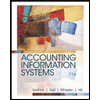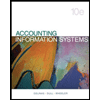
Analysis Case 20–4
Change in inventory methods; concepts
• LO20–2, LO20–3
Generally accepted accounting principles should be applied consistently from period to period. However, changes within a company, as well as changes in the external economic environment, may force a company to change an accounting method. The specific reporting requirements when a company changes from one generally accepted inventory method to another depend on the methods involved.
Required:
Explain the accounting treatment for a change in inventory method (a) not involving LIFO, (b) from the LIFO method, and (c) to the LIFO method. Explain the logic underlying those treatments. Also, describe how disclosure requirements are designed to address the departure from consistency and comparability of changes in accounting principle.
Want to see the full answer?
Check out a sample textbook solution
Chapter 20 Solutions
Intermediate Accounting
- I am looking for help with this general accounting question using proper accounting standards.arrow_forwardI need the correct answer to this financial accounting problem using the standard accounting approach.arrow_forwardBurlington Audio Works was organized on January 3, 2016. During 2018, Burlington Audio issued 30,000 shares at $18 per share, purchased 5,000 shares of treasury stock at $20 per share, and had a net income of $210,000. What is the total amount of stockholders' equity at December 31, 2018?arrow_forward
- Please provide the correct answer to this general accounting problem using accurate calculations.arrow_forwardComputer the increase in net income Baldwin will realize by accepting the special order ,assuming the company has sufficient excess operating capity.arrow_forwardI need assistance with this general accounting question using appropriate principles.arrow_forward
- Can you help me solve this general accounting question using the correct accounting procedures?arrow_forwardI need assistance with this financial accounting problem using valid financial procedures.arrow_forwardCan you solve this general accounting problem with appropriate steps and explanations?arrow_forward
 Accounting Information SystemsFinanceISBN:9781337552127Author:Ulric J. Gelinas, Richard B. Dull, Patrick Wheeler, Mary Callahan HillPublisher:Cengage Learning
Accounting Information SystemsFinanceISBN:9781337552127Author:Ulric J. Gelinas, Richard B. Dull, Patrick Wheeler, Mary Callahan HillPublisher:Cengage Learning Individual Income TaxesAccountingISBN:9780357109731Author:HoffmanPublisher:CENGAGE LEARNING - CONSIGNMENT
Individual Income TaxesAccountingISBN:9780357109731Author:HoffmanPublisher:CENGAGE LEARNING - CONSIGNMENT Auditing: A Risk Based-Approach (MindTap Course L...AccountingISBN:9781337619455Author:Karla M Johnstone, Audrey A. Gramling, Larry E. RittenbergPublisher:Cengage Learning
Auditing: A Risk Based-Approach (MindTap Course L...AccountingISBN:9781337619455Author:Karla M Johnstone, Audrey A. Gramling, Larry E. RittenbergPublisher:Cengage Learning Financial Reporting, Financial Statement Analysis...FinanceISBN:9781285190907Author:James M. Wahlen, Stephen P. Baginski, Mark BradshawPublisher:Cengage Learning
Financial Reporting, Financial Statement Analysis...FinanceISBN:9781285190907Author:James M. Wahlen, Stephen P. Baginski, Mark BradshawPublisher:Cengage Learning Cornerstones of Financial AccountingAccountingISBN:9781337690881Author:Jay Rich, Jeff JonesPublisher:Cengage Learning
Cornerstones of Financial AccountingAccountingISBN:9781337690881Author:Jay Rich, Jeff JonesPublisher:Cengage Learning Pkg Acc Infor Systems MS VISIO CDFinanceISBN:9781133935940Author:Ulric J. GelinasPublisher:CENGAGE L
Pkg Acc Infor Systems MS VISIO CDFinanceISBN:9781133935940Author:Ulric J. GelinasPublisher:CENGAGE L





